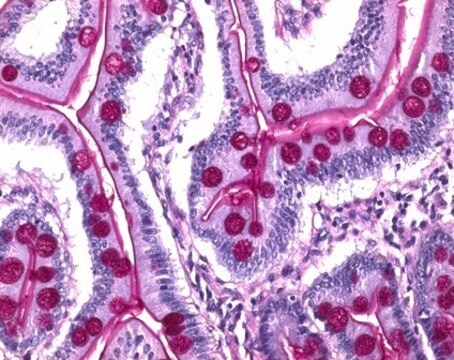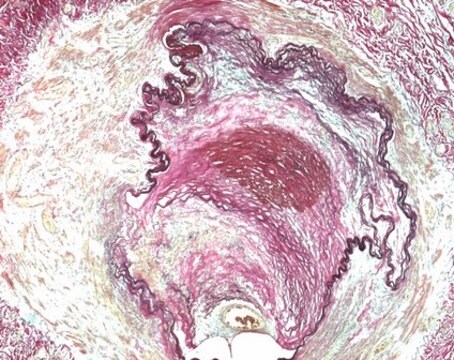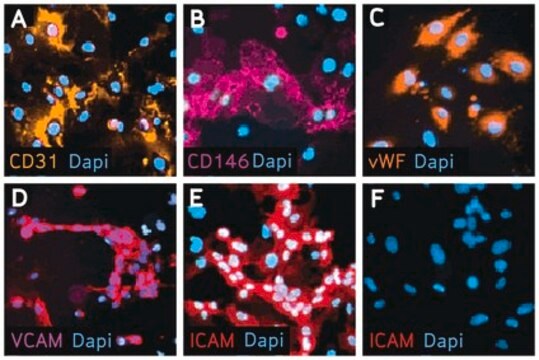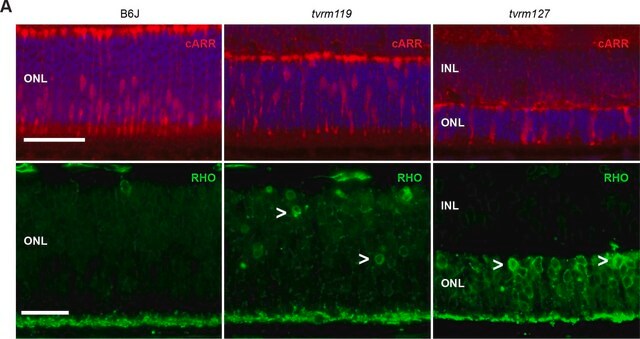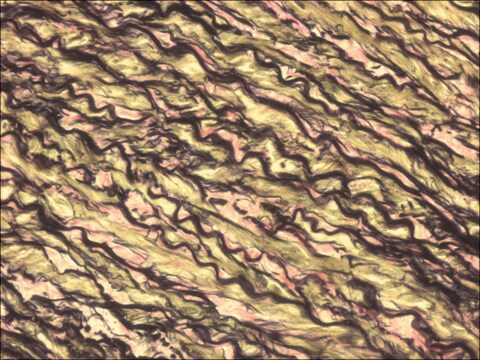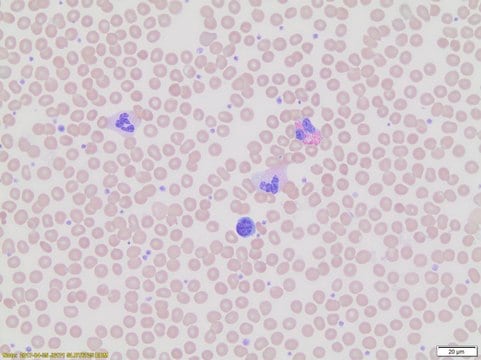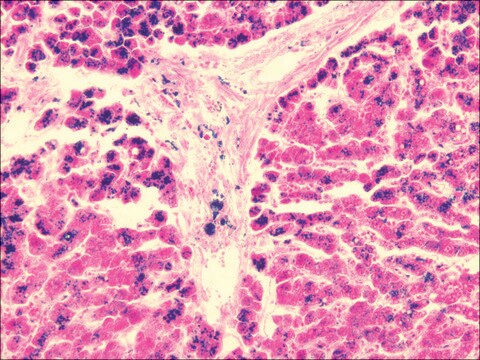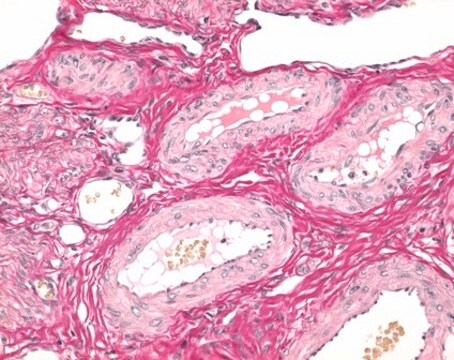ECM590
Blood Vessel Staining Kit
Reagents & materials supplied in the Blood Vessel Staining Kit are sufficient for staining 100 tissue sections & when stored at 2-8ºC is stable up to the expiration date.
Sign Into View Organizational & Contract Pricing
All Photos(2)
About This Item
UNSPSC Code:
12161503
eCl@ss:
32161000
Recommended Products
Quality Level
species reactivity
human
manufacturer/tradename
Chemicon®
technique(s)
immunohistochemistry (formalin-fixed, paraffin-embedded sections): suitable
detection method
colorimetric
shipped in
wet ice
General description
Reagents and materials supplied in the Blood Vessel Staining Kit are sufficient for staining 100 tissue sections and when stored at 2-8ºC is stable up to the expiration date. ECM590 detects vWF and CD31 in human paraffin embedded tissues. In rat or mouse tissues only the vWF antibody is effective in paraffin; the CD31 antibody does not react with rodent CD31.
Background:
Angiogenesis and tumor-associated neovascularization are complex processes by which new blood vessels are formed from pre-existing vasculature. Several studies implicate tumor-associated blood vessel formation as a central part in the process of growth, invasion and metastasis of malignancies (Rak et al., 1995; Jahroudi & Greenberger, 1995; Saphir, 1997).
The most widely used endothelial cell markers for studying angiogenesis/neovascularization are von Willebrand Factor (Factor VIII Related Antigen) and CD31 (PECAM-1). von Willebrand Factor is synthesized by endothelial cells, causing adhesion of platelets to injured vessel walls and functions as a carrier and stabilizer for coagulation of Factor VIII. CHEMICON′s von Willebrand Factor antibody reacts specifically with the endothelial cells of blood vessels and is a useful marker for the identification of endothelial lineage in tumors. It is important to note that not all endothelial cells synthesize von Willebrand factor, therefore a small percentage of these vascular-rich tumors might not stain with this antibody. CD31 or platelet endothelial adhesion molecule (PECAM-1), is a type I integral membrane glycoprotein and a member of the immunoglobulin super family of cell surface receptors. It is strongly expressed by all endothelial cells and weakly by several types of leucocytes (Parums et al., 1990). According to several studies, staining of blood vessels with CD31 antibodies has shown to be suitable for the identification of angiogenesis in several types of malignancies such as lung (Giatromanolaki et al., 1996), breast (Horak et al., 1992) and colorectal cancer (Takebayashi et al., 1996). CHEMICON′s monoclonal antibody to CD31 is very specific for the staining of vascular endothelial cells in normal and cancerous tissue.
CHEMICON′s Blood Vessel Staining Kit is a very sensitive immunohistochemical tool for the detection of vascular endothelial cells, containing both anti-von Willebrand Factor and anti-CD31 primary antibodies and is applicable to a variety of species. This immunoperoxidase kit provides a simple, all-in-one method for the staining of frozen and paraffin-embedded sections in human (both CD31 and VWF) or rat and mouse (VWF only) tissues
Background:
Angiogenesis and tumor-associated neovascularization are complex processes by which new blood vessels are formed from pre-existing vasculature. Several studies implicate tumor-associated blood vessel formation as a central part in the process of growth, invasion and metastasis of malignancies (Rak et al., 1995; Jahroudi & Greenberger, 1995; Saphir, 1997).
The most widely used endothelial cell markers for studying angiogenesis/neovascularization are von Willebrand Factor (Factor VIII Related Antigen) and CD31 (PECAM-1). von Willebrand Factor is synthesized by endothelial cells, causing adhesion of platelets to injured vessel walls and functions as a carrier and stabilizer for coagulation of Factor VIII. CHEMICON′s von Willebrand Factor antibody reacts specifically with the endothelial cells of blood vessels and is a useful marker for the identification of endothelial lineage in tumors. It is important to note that not all endothelial cells synthesize von Willebrand factor, therefore a small percentage of these vascular-rich tumors might not stain with this antibody. CD31 or platelet endothelial adhesion molecule (PECAM-1), is a type I integral membrane glycoprotein and a member of the immunoglobulin super family of cell surface receptors. It is strongly expressed by all endothelial cells and weakly by several types of leucocytes (Parums et al., 1990). According to several studies, staining of blood vessels with CD31 antibodies has shown to be suitable for the identification of angiogenesis in several types of malignancies such as lung (Giatromanolaki et al., 1996), breast (Horak et al., 1992) and colorectal cancer (Takebayashi et al., 1996). CHEMICON′s monoclonal antibody to CD31 is very specific for the staining of vascular endothelial cells in normal and cancerous tissue.
CHEMICON′s Blood Vessel Staining Kit is a very sensitive immunohistochemical tool for the detection of vascular endothelial cells, containing both anti-von Willebrand Factor and anti-CD31 primary antibodies and is applicable to a variety of species. This immunoperoxidase kit provides a simple, all-in-one method for the staining of frozen and paraffin-embedded sections in human (both CD31 and VWF) or rat and mouse (VWF only) tissues
Application
ECM590 detects vWF and CD31 in human paraffin embedded tissues. In rat or mouse tissues only the vWF antibody is effective in paraffin; the CD31 antibody does not react with rodent CD31.
Reagents & materials supplied in the Blood Vessel Staining Kit are sufficient for staining 100 tissue sections & when stored at 2-8ºC is stable up to the expiration date.
Research Category
Cell Structure
Cell Structure
Packaging
sufficient for 100 sections
Components
Rabbit anti-vWF Polyclonal Antibody (Part No. 21540): One vial containing 100 μg at 1 mg/mL.
Mouse anti-CD31 Monoclonal Antibody (Part No. 90214): One vial containing 100 μL at 15 mg/mL (total protein including IgG and Carrier protein).
Goat anti-Rabbit Secondary Antibody (Part No. 21537): One 15 mL ready-to-use solution containing biotinylated goat anti-rabbit IgG in PBS with a carrier protein.
Goat anti-Mouse Secondary Antibody (Part No. 21538): One 15 mL ready-to-use solution containing biotinylated goat anti-mouse IgG in PBS with a carrier protein.
Blocking Reagent (Part No. 20783): One 15 mL ready-to-use solution containing normal goat serum in PBS with a carrier protein.
Streptavidin-HRP (Part No. 90215): One 15 ml ready-to-use solution of Streptavidin-HRP diluted in Tris-buffered saline (TBS).
DAB Chromogen A (Part No. 90216): One 5 mL bottle of 3, 3′ Diaminobenzidine diluted in TBS.
DAB Chromogen B (Part No: 90217): Two 12 mL bottles of hydrogen peroxide diluted in distilled water.
20X Rinse Buffer (Part No. 90218): One 275 mL bottle of 20X TBS.
Mouse anti-CD31 Monoclonal Antibody (Part No. 90214): One vial containing 100 μL at 15 mg/mL (total protein including IgG and Carrier protein).
Goat anti-Rabbit Secondary Antibody (Part No. 21537): One 15 mL ready-to-use solution containing biotinylated goat anti-rabbit IgG in PBS with a carrier protein.
Goat anti-Mouse Secondary Antibody (Part No. 21538): One 15 mL ready-to-use solution containing biotinylated goat anti-mouse IgG in PBS with a carrier protein.
Blocking Reagent (Part No. 20783): One 15 mL ready-to-use solution containing normal goat serum in PBS with a carrier protein.
Streptavidin-HRP (Part No. 90215): One 15 ml ready-to-use solution of Streptavidin-HRP diluted in Tris-buffered saline (TBS).
DAB Chromogen A (Part No. 90216): One 5 mL bottle of 3, 3′ Diaminobenzidine diluted in TBS.
DAB Chromogen B (Part No: 90217): Two 12 mL bottles of hydrogen peroxide diluted in distilled water.
20X Rinse Buffer (Part No. 90218): One 275 mL bottle of 20X TBS.
Storage and Stability
Do not freeze or expose to elevated temperatures. Discard any remaining reagents after the expiration date. Do not store kit components or perform staining in strong light, such as direct sunlight.
Legal Information
CHEMICON is a registered trademark of Merck KGaA, Darmstadt, Germany
Disclaimer
Unless otherwise stated in our catalog or other company documentation accompanying the product(s), our products are intended for research use only and are not to be used for any other purpose, which includes but is not limited to, unauthorized commercial uses, in vitro diagnostic uses, ex vivo or in vivo therapeutic uses or any type of consumption or application to humans or animals.
Storage Class Code
10 - Combustible liquids
Certificates of Analysis (COA)
Search for Certificates of Analysis (COA) by entering the products Lot/Batch Number. Lot and Batch Numbers can be found on a product’s label following the words ‘Lot’ or ‘Batch’.
Already Own This Product?
Find documentation for the products that you have recently purchased in the Document Library.
Y Takebayashi et al.
Cancer, 78(2), 226-231 (1996-07-15)
Angiogenesis is reportedly correlated with metastasis, relapse, and prognosis in some types of tumors. Hematogenous or lymph node metastasis and local recurrence are the main elements related to the death of patients with colorectal carcinoma. Thus, the authors examined the
Sahar Vahabzadeh et al.
Journal of materials chemistry. B, 3(46), 8973-8982 (2016-02-09)
Calcium phosphate cements (CPCs) are being widely used for treating small scale bone defects. Among the various CPCs, brushite (dicalcium phosphate dihydrate, DCPD) cement is widely used due to its superior solubility and ability to form new bone. In the
Jerome A Henry et al.
Acta biomaterialia, 5(1), 29-42 (2008-10-01)
The aim of this study was to investigate an in vivo tissue response to a biodegradable polyesterurethane, specifically the cellular and angiogenic response evoked by varying implant architectures in a subcutaneous rabbit implant model. A synthetic biodegradable polyesterurethane was synthesized
A Giatromanolaki et al.
The Journal of pathology, 179(1), 80-88 (1996-05-01)
Tumour angiogenesis is an important factor for tumour growth and metastasis. Although some recent reports suggest that microvessel counts in non-small cell lung cancer are related to a poor disease outcome, the results were not conclusive and were not compared
Chi-Tat Lam et al.
Clinical cancer research : an official journal of the American Association for Cancer Research, 17(10), 3123-3133 (2011-03-23)
Brain-derived neurotrophic factor (BDNF) has emerged as a novel angiogenic factor, and yet its impact on tumorigenesis is unclear. This study aimed at investigating the roles of BDNF in angiogenesis and tumor development. BDNF was overexpressed in a mouse endothelial
Our team of scientists has experience in all areas of research including Life Science, Material Science, Chemical Synthesis, Chromatography, Analytical and many others.
Contact Technical Service